QUESTION
How do I create a Dutch hip or Dutch gable roof?

ANSWER
A Dutch hip roof, sometimes called a Dutch gable roof, is a combination of hip and gable roof styles in which a gable is located at the end of the ridge, and at the top of a hip roof plane. Creating a Dutch hip roof is easy to do by following the steps below.
To create a Dutch hip roof automatically
-
Open
 a plan in which you would like to create a Dutch hip roof on.
a plan in which you would like to create a Dutch hip roof on.
In this example, a simple 20' x 30' building with 109 1/8" ceiling height is used.
- Select the wall you would like to build a Dutch hip over and click on the Open Object
 edit button.
edit button.
- In the Wall Specification dialog that opens, click on the Roof panel, select the Dutch Gable Wall option, set the Pitch, the Starts at Height or In from Baseline value, then click OK to confirm the changes.
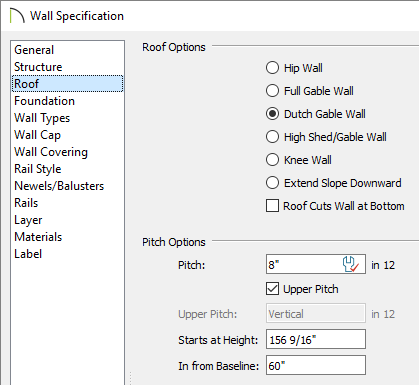
- If Auto Rebuild Roofs is not enabled, select Build> Roof> Build Roof
 from the menu, check the Build Roof Planes box in the dialog that displays, then click OK to automatically generate a roof with a Dutch hip over the wall that was modified.
from the menu, check the Build Roof Planes box in the dialog that displays, then click OK to automatically generate a roof with a Dutch hip over the wall that was modified.
In Home Designer Suite and Home Designer Architectural, open the Build Roof dialog and click OK to build roof planes.

You can also check the Auto Rebuild Roofs box if you'd like your roofs to update automatically anytime a change is made to a wall.
- Select 3D> Create Perspective View> Perspective Full Overview
 to see the results.
to see the results.
In Home Designer Suite and Home Designer Architectural, navigate to 3D> Create Camera View> Perspective Full Overview  instead.
instead.

To create a Dutch hip roof manually
Applies to Chief Architect Premier, Chief Architect Interiors, and Home Designer Pro.
-
Open
 a plan in which you would like to create a Dutch hip roof on.
a plan in which you would like to create a Dutch hip roof on.
In this example, a simple 20' x 30' building with 109 1/8" ceiling height is used.
- Navigate to Build> Roof> Build Roof
 from the menu.
from the menu.
- On the Roof panel of the Build Roof dialog that displays, uncheck Auto Rebuild Roofs, check Build Roof Planes, then click OK to close the dialog and generate a hip roof.
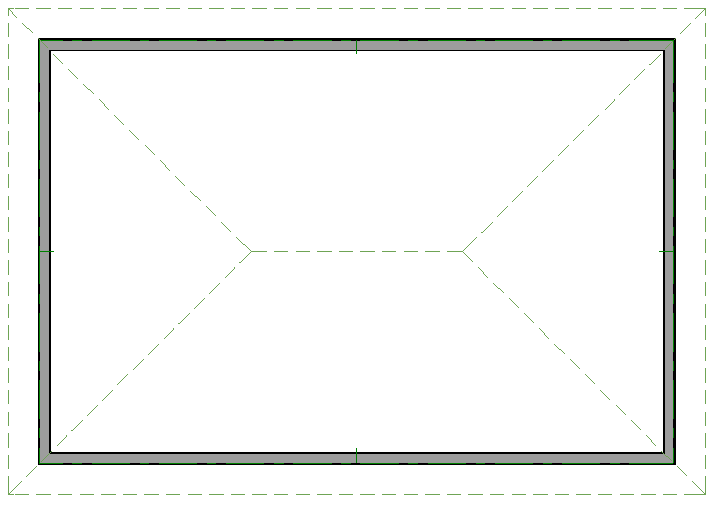
- Click on one of the side edges of a roof plane in which you would like to build a Dutch hip to select it along that edge.
- Click the Add Break
 edit button, then click once along the edge that you selected to place a corner handle or 'joint' at that location. Do not worry about exact placement at this time.
edit button, then click once along the edge that you selected to place a corner handle or 'joint' at that location. Do not worry about exact placement at this time.
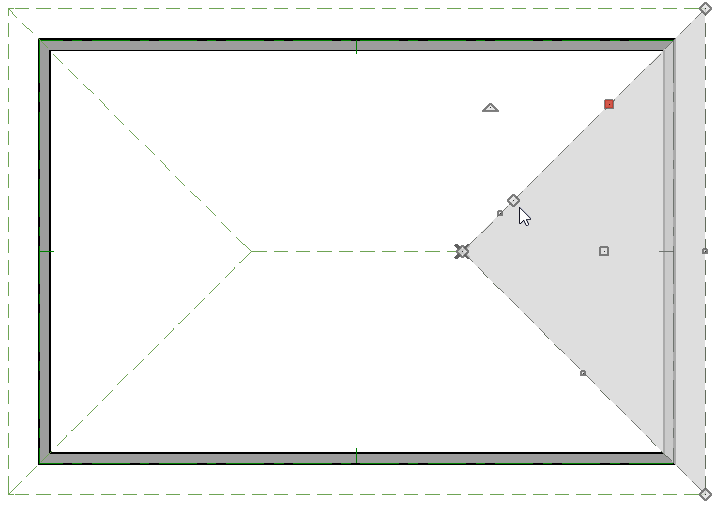
- Click on the edit handle that displays at the peak of the roof plane and drag it down to produce a triangular-shaped opening in the roof.

- Select Tools> Floor/Reference Display> Up One Floor
 to go up to the Attic level.
to go up to the Attic level.
- Select Tools> Floor/Reference Display> Reference Display
 from the menu to display the 1st floor walls and roof planes as red lines.
from the menu to display the 1st floor walls and roof planes as red lines.
If your roof planes do not display as part of the Reference Display, navigate to Tools> Floor/Reference Display> Change Floor Reference  . In the Change Floor/Reference dialog that appears, click on Define located next to the Layer Set column or the Reference Display Options line. In the Layer Display Options dialog that displays next, place a check in the Disp column for the "Roof Planes" layer, then click OK. Click OK again to return to the floor plan.
. In the Change Floor/Reference dialog that appears, click on Define located next to the Layer Set column or the Reference Display Options line. In the Layer Display Options dialog that displays next, place a check in the Disp column for the "Roof Planes" layer, then click OK. Click OK again to return to the floor plan.
- Select Build> Wall> Straight Exterior Wall
 from the menu, then click and drag along the edge of the roof plane edge that you created in steps 4-6. This will be the gable wall.
from the menu, then click and drag along the edge of the roof plane edge that you created in steps 4-6. This will be the gable wall.
- The exterior surface of the wall should be just inside, or above, the top edge of the hip roof.
- If it's too low or too high, click on the wall to select it and use the Move
 edit handle to move it into the correct location.
edit handle to move it into the correct location.
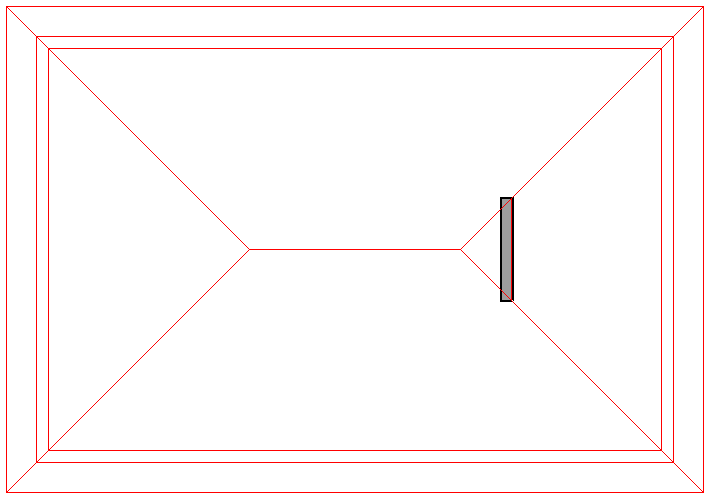
- Alternatively, you may wish to move the roof plane edge to make room for the gable wall.
- Select Tools> Floor/Reference Display> Down One Floor
 to return to Floor 1. Notice the gable wall that was placed in the attic displays a red outline.
to return to Floor 1. Notice the gable wall that was placed in the attic displays a red outline.
- Click on one of the roof planes on either side of the Dutch hip to select it, click the Add Break
 edit button, then click once along that edge to place a break at that location, as in step 5 above.
edit button, then click once along that edge to place a break at that location, as in step 5 above.
- Click and drag the edit handle at the ridge to create a new edge that is parallel to the gable wall.
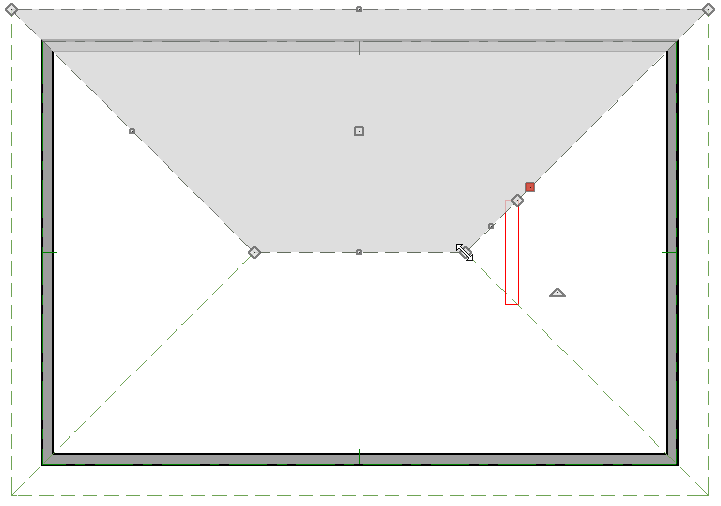
- Click the Make Parallel
 edit button and click on the wall that the Dutch hip is bearing on to make it parallel to that wall.
edit button and click on the wall that the Dutch hip is bearing on to make it parallel to that wall.
- Adjust the position of the roof edge to create an overhang.
- Repeat step 10 with the roof plane on the opposite side of the Dutch hip.

- Select 3D> Create Perspective View> Perspective Full Overview
 to see the results.
to see the results.









 edit button, then click once along the edge that you selected to place a corner handle or 'joint' at that location. Do not worry about exact placement at this time.
edit button, then click once along the edge that you selected to place a corner handle or 'joint' at that location. Do not worry about exact placement at this time.

 from the menu, then click and drag along the edge of the roof plane edge that you created in steps 4-6. This will be the gable wall.
from the menu, then click and drag along the edge of the roof plane edge that you created in steps 4-6. This will be the gable wall. 
 edit button, then click once along that edge to place a break at that location, as in step 5 above.
edit button, then click once along that edge to place a break at that location, as in step 5 above. 

